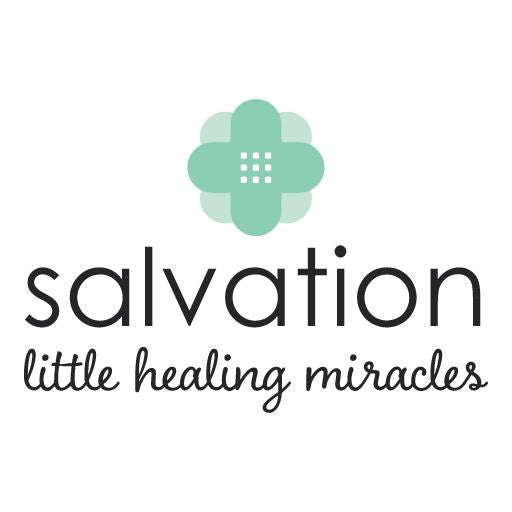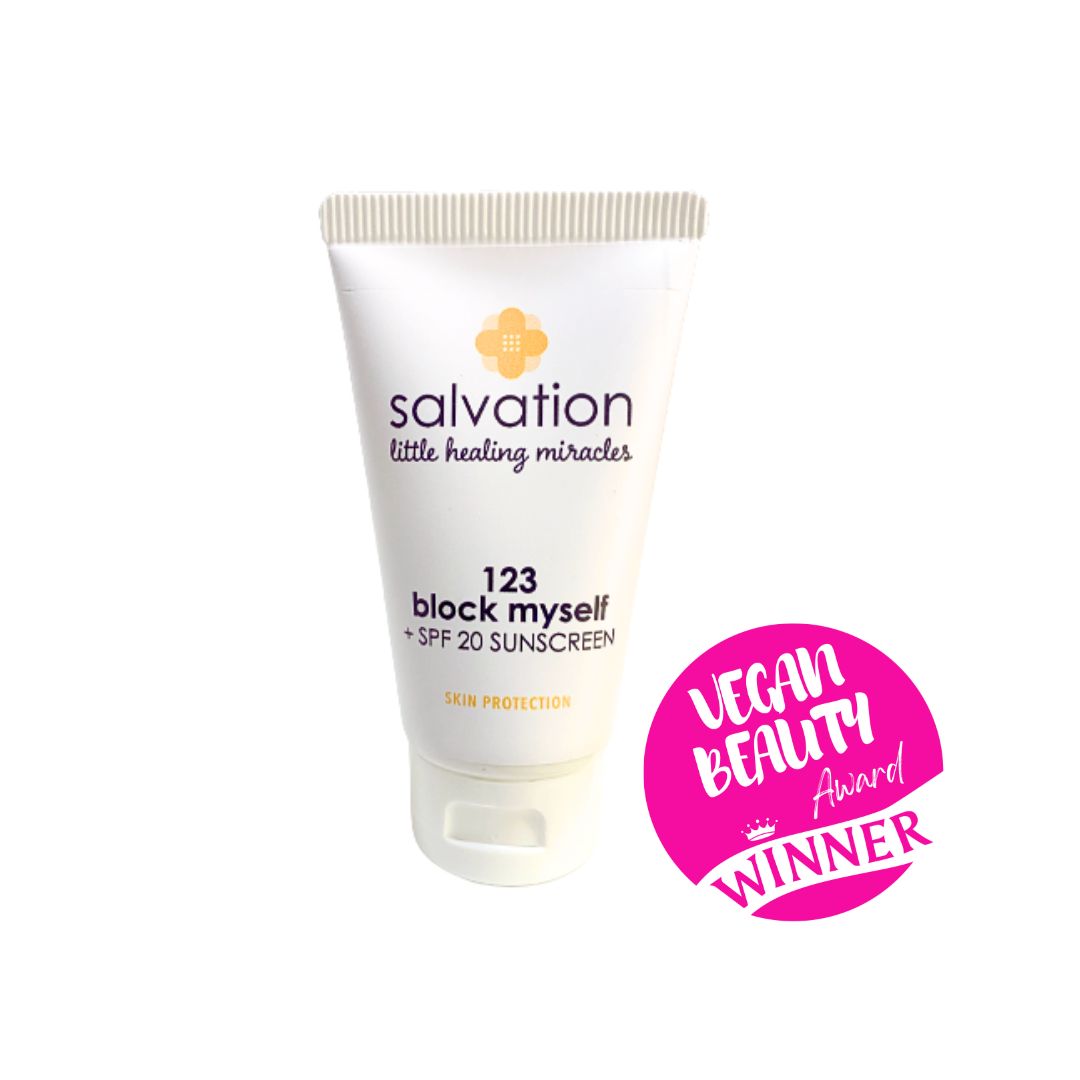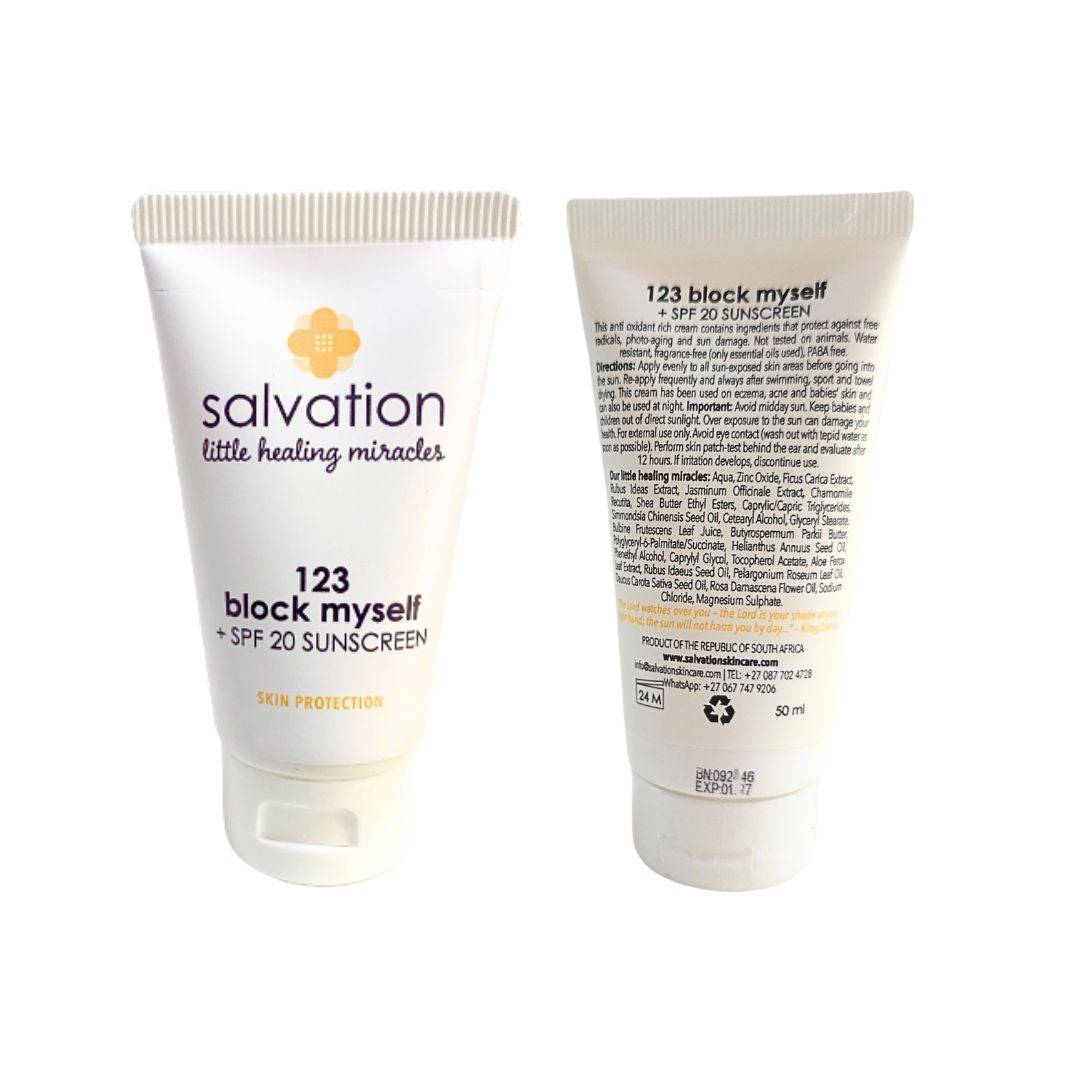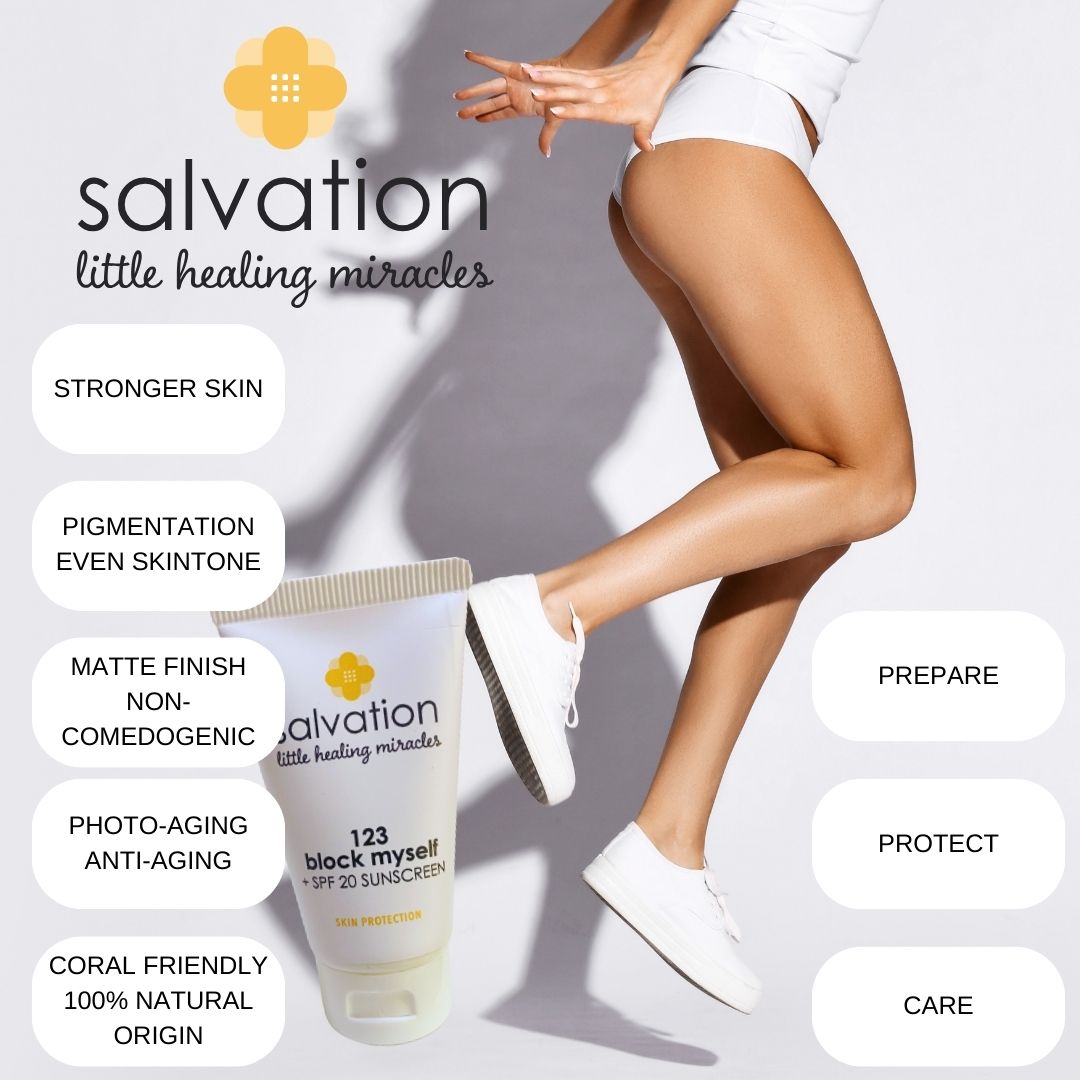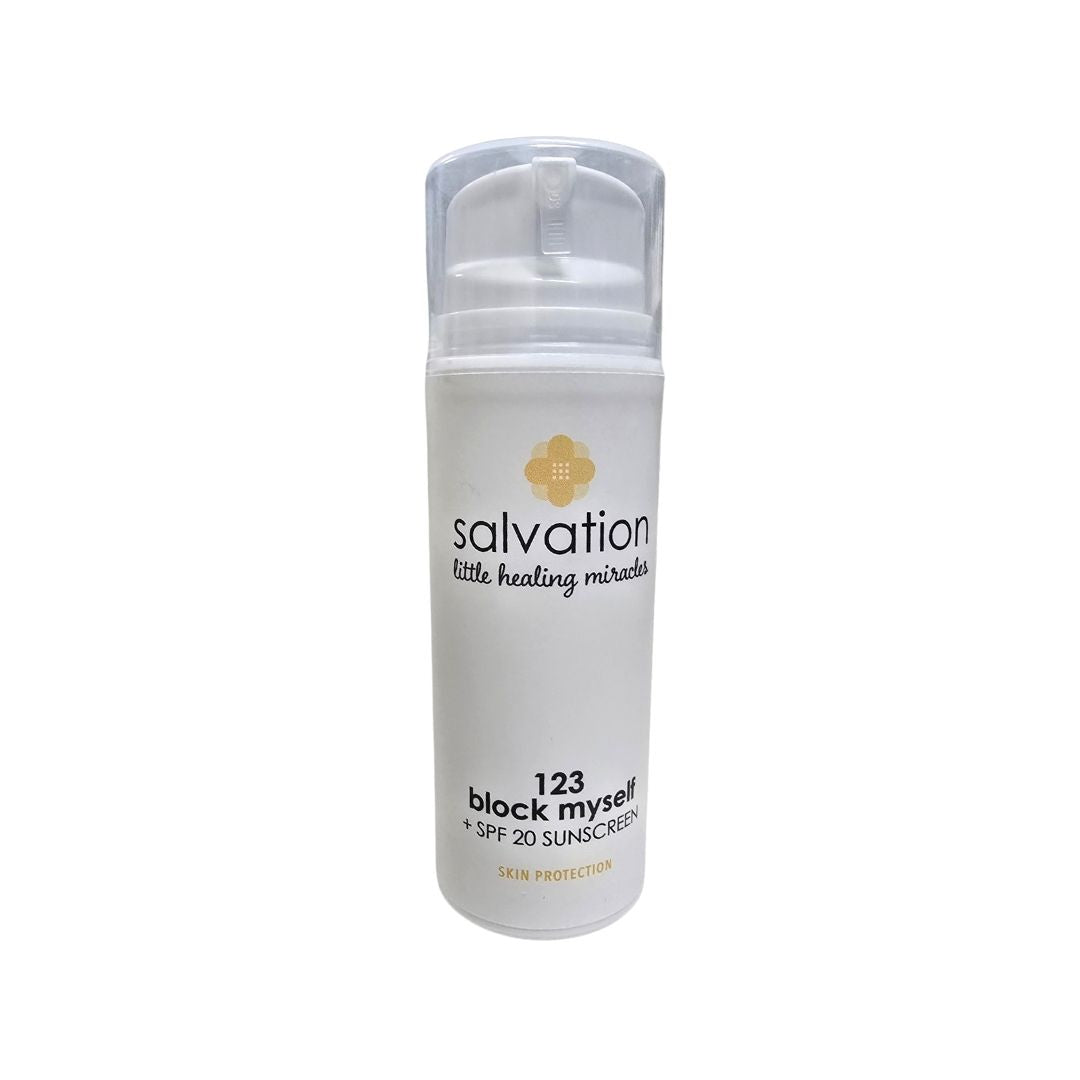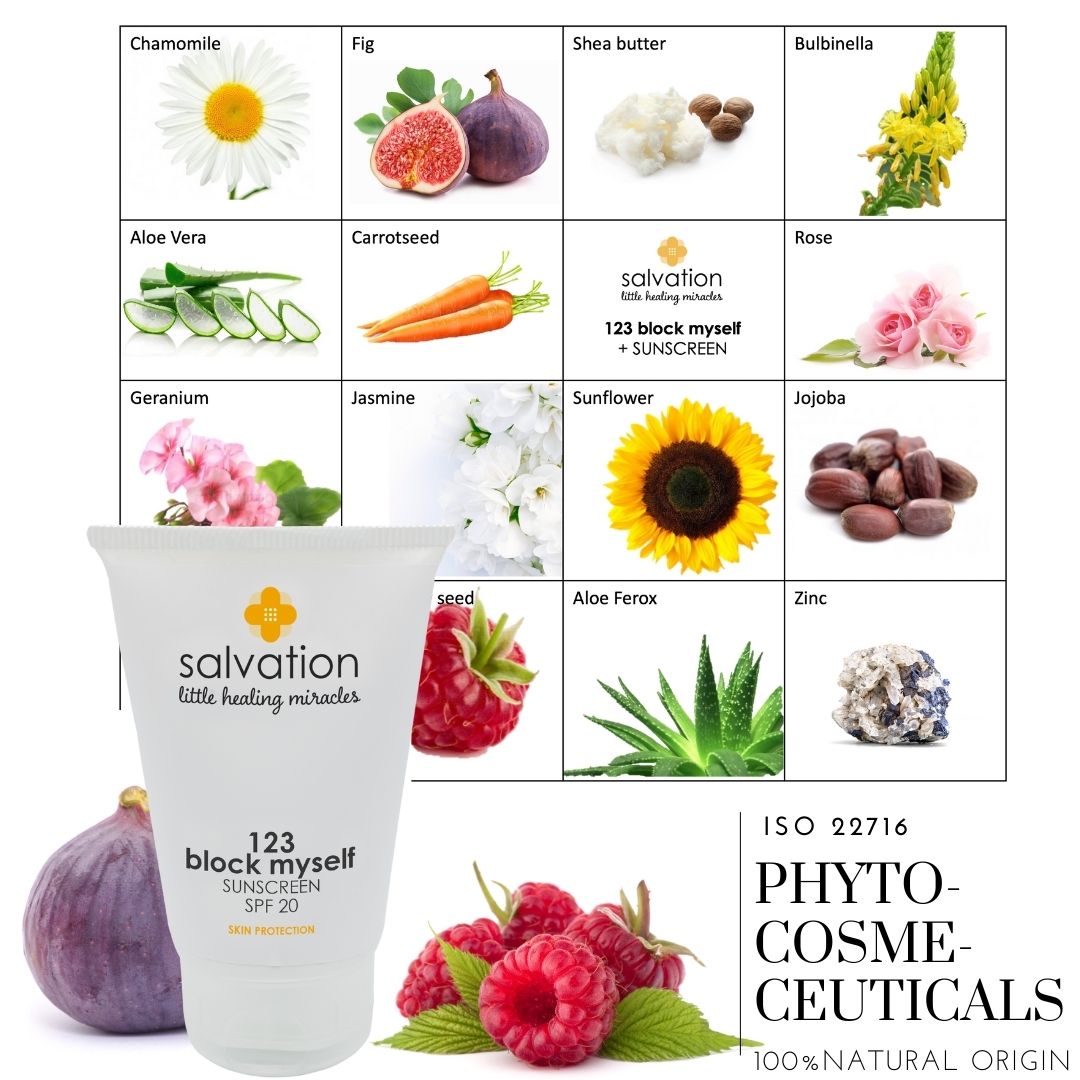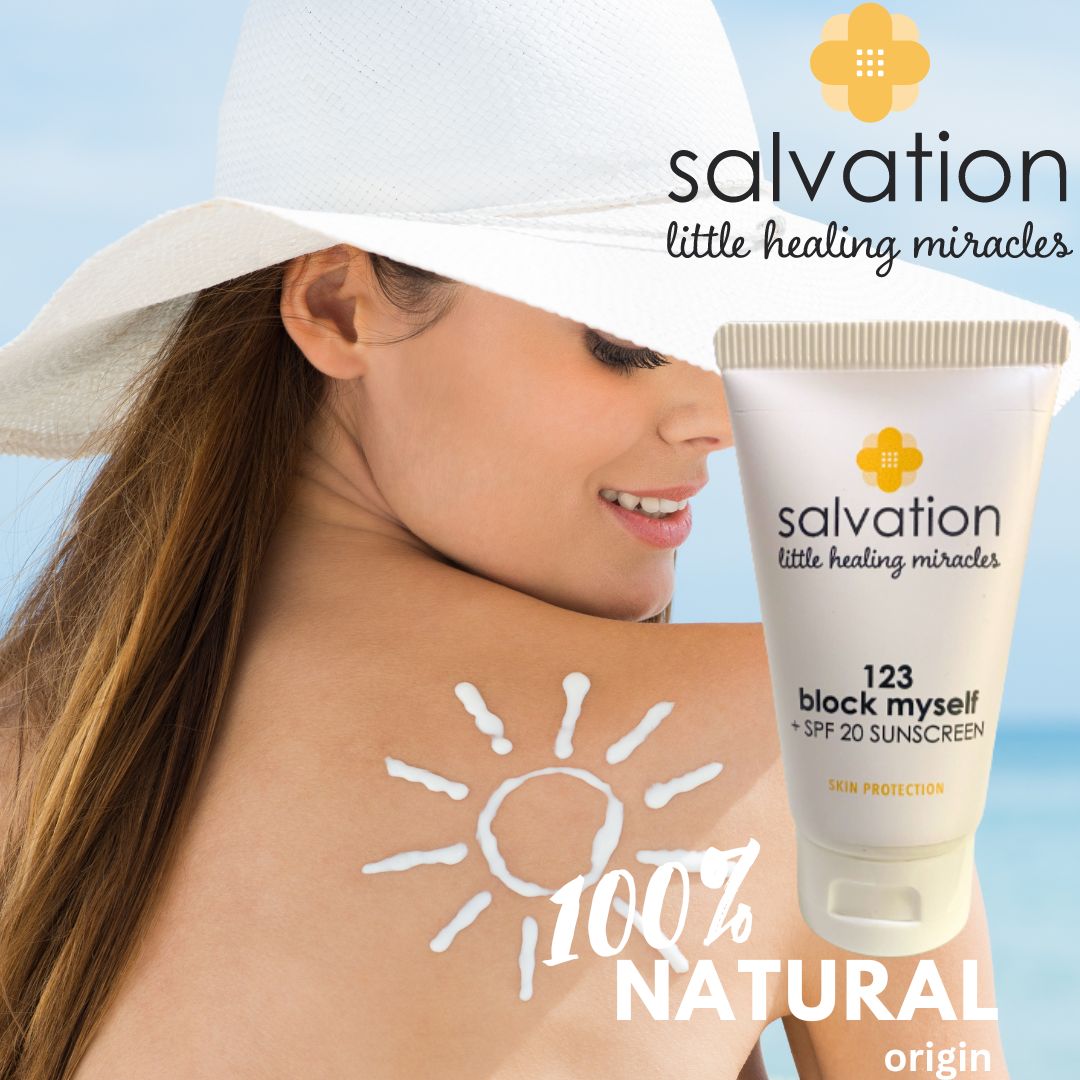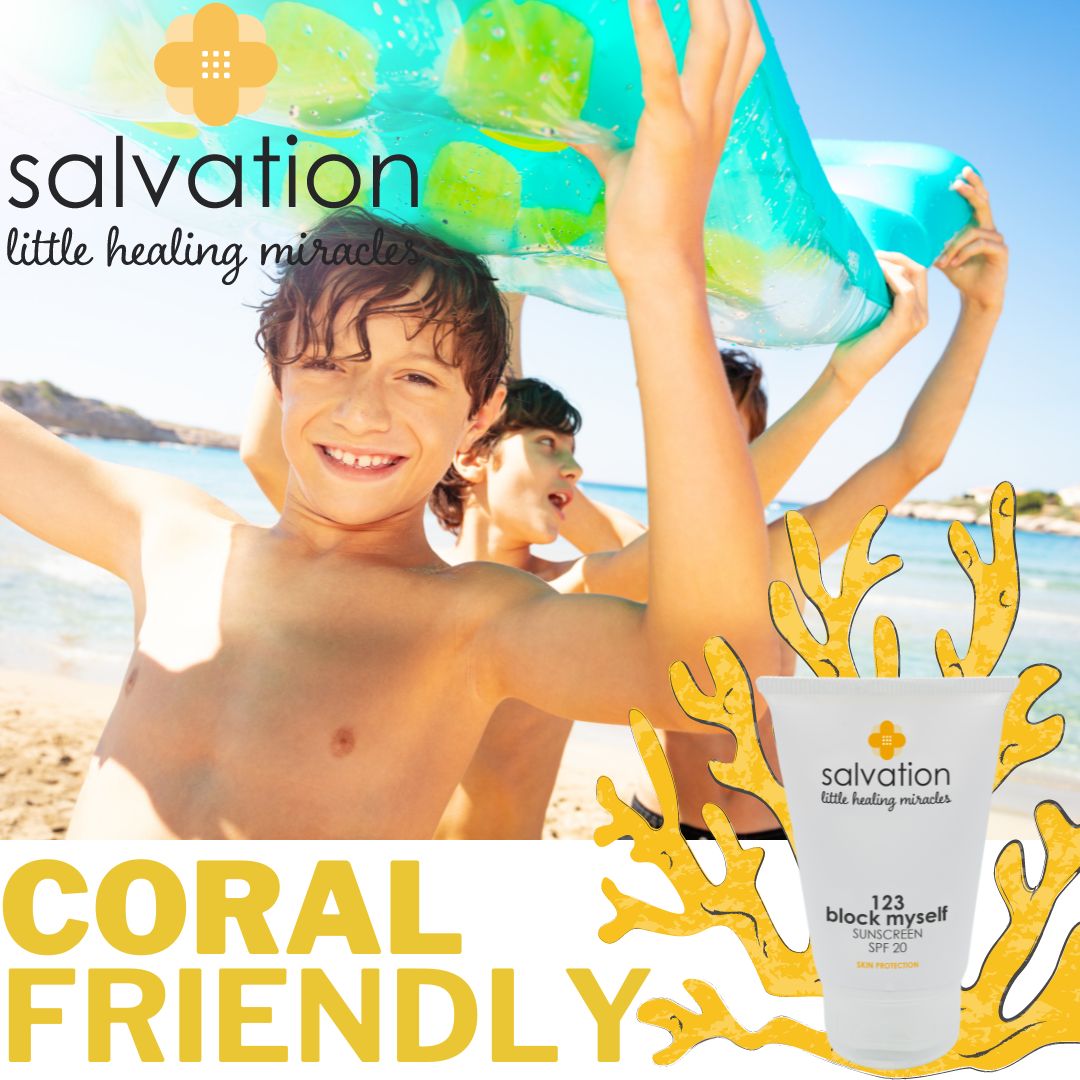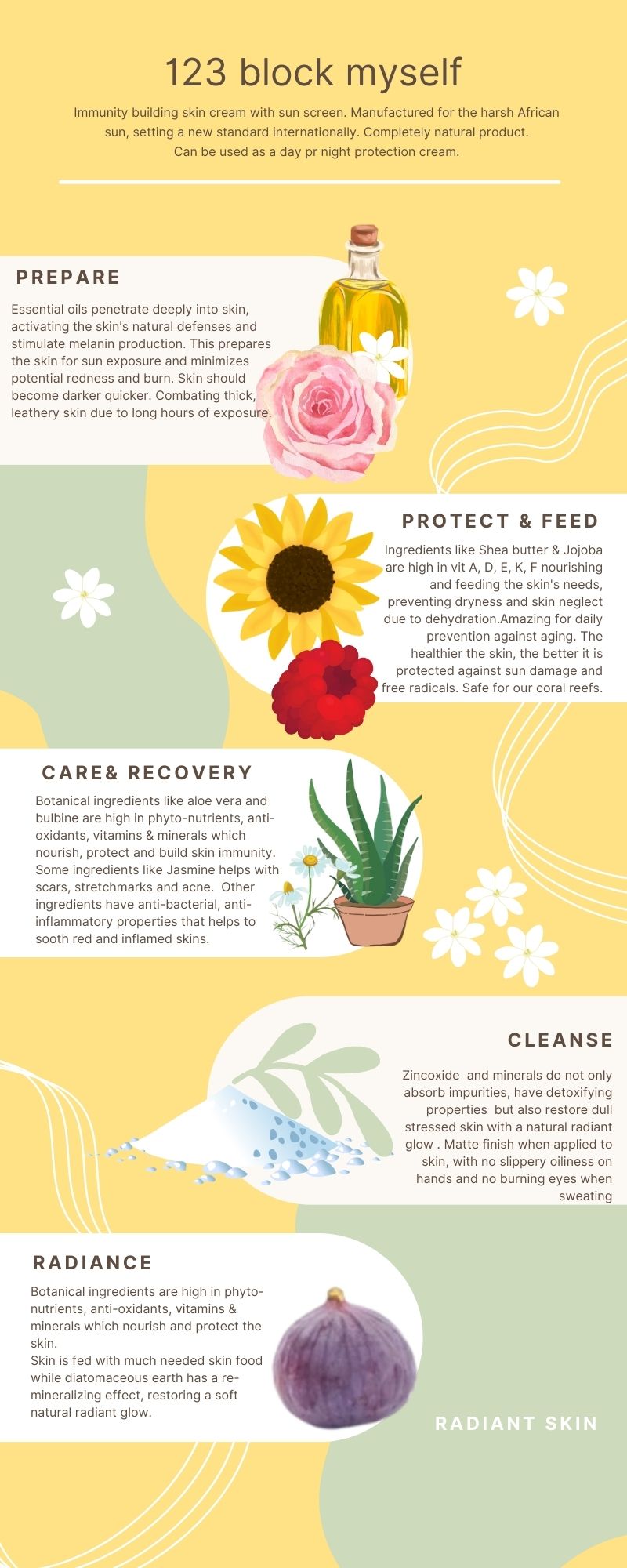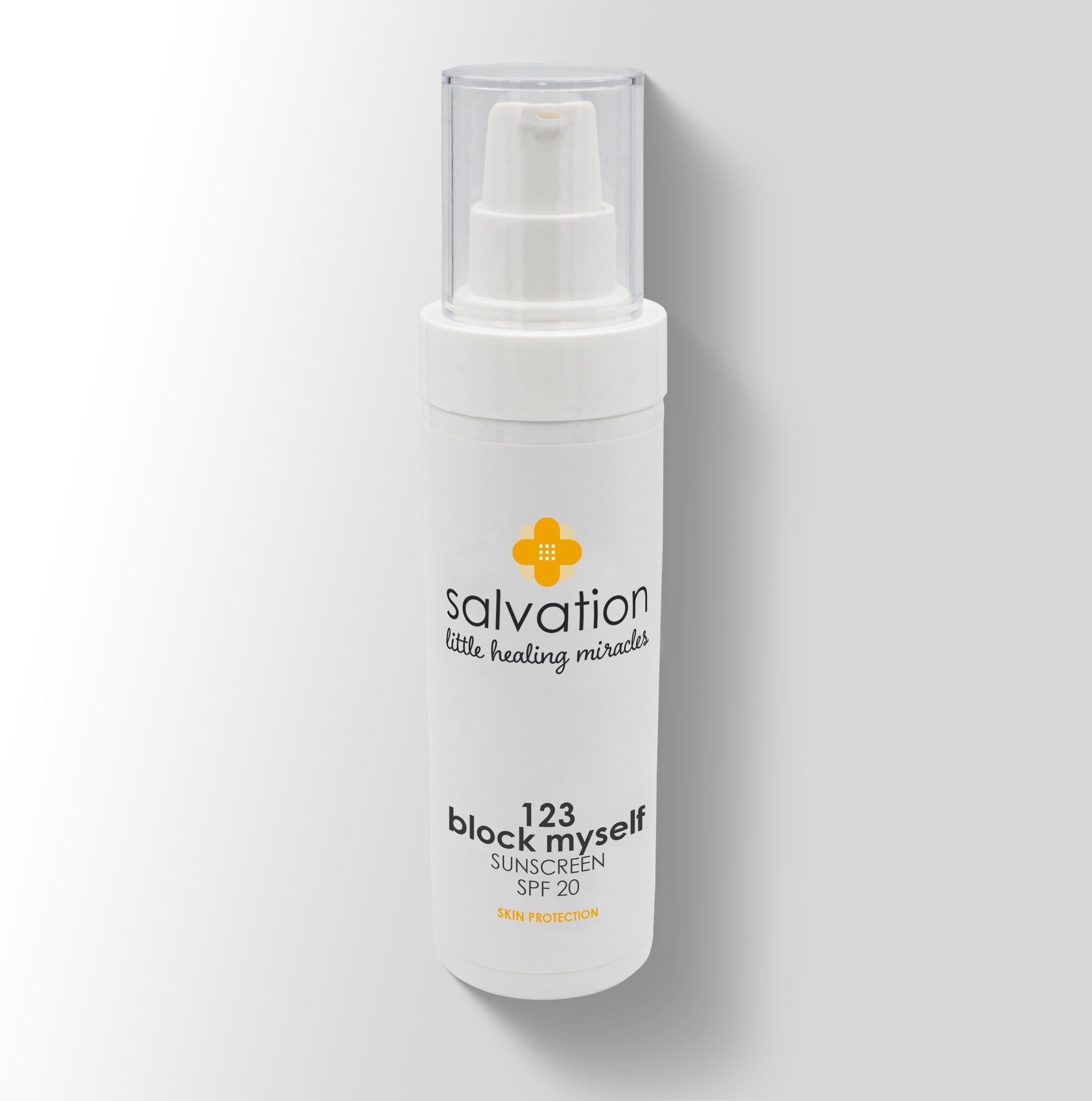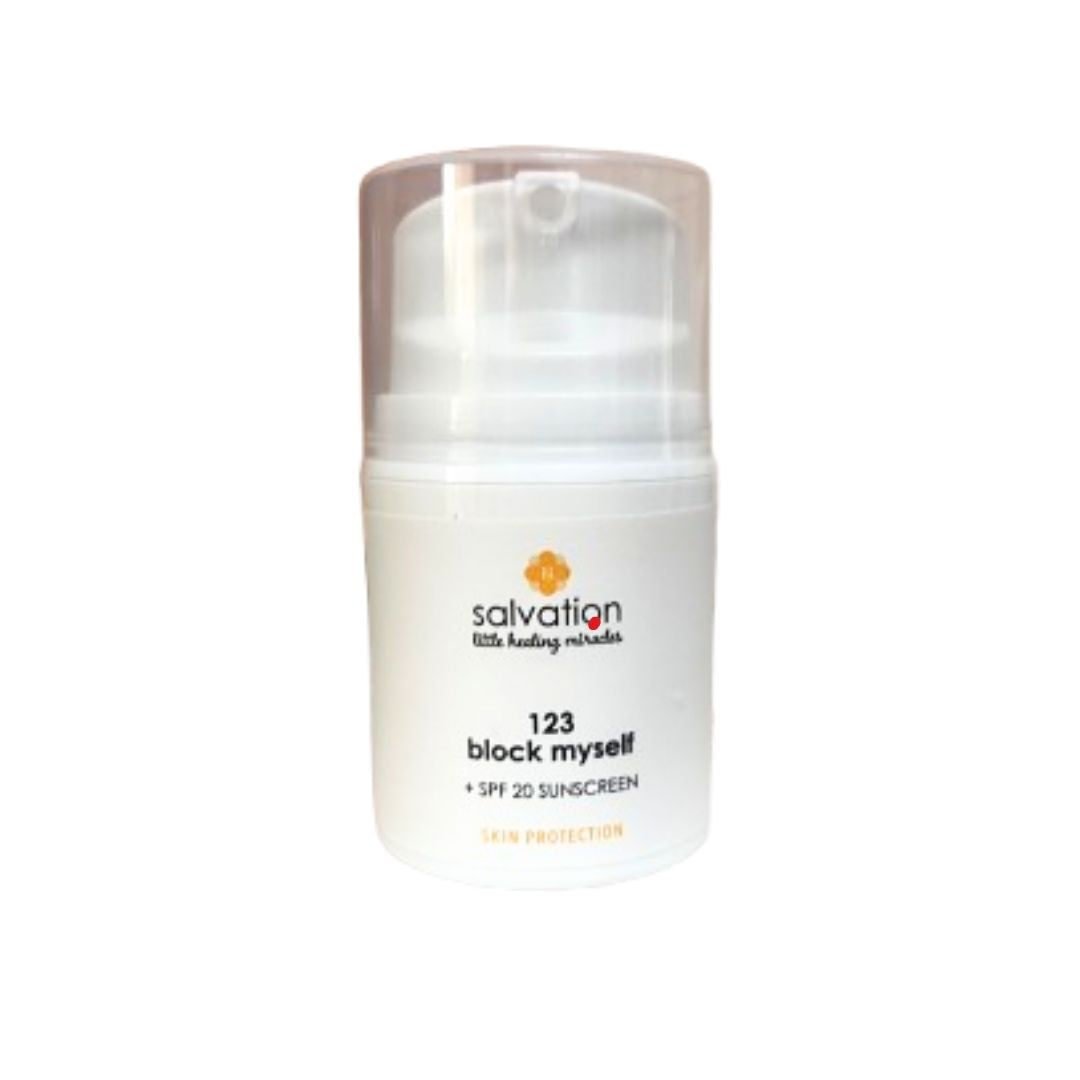Salvation little healing miracles
123 BLOCK MYSELF with SPF 20 sunscreen
123 BLOCK MYSELF with SPF 20 sunscreen
 2–3 Days Delivery
2–3 Days Delivery
 Pickup Available
Pickup Available
 14 Days Returns
14 Days Returns
Couldn't load pickup availability
Secure Payment Methods

1...2...3...
PREPARE PROTECT CARE
Immunity building cream with sunscreen: safe for the whole family- giving protection before, during and after sun exposure.
PRODUCT HIGHLIGHTS:
- one product with many uses, minimalistic skincare
- protection from UVA & UVB (and indirectly from UVC)
- matte finish, no stickiness or oily shine
- easy absorption, no white residue
- protection even when in the water or sweating
- all-natural origin (no bad or banned ingredients)
- assists to lighten skintone and prevent pigmentation
- softens skin & helps it recover faster
- assists hydration without stimulating oiliness
- non-comedogenic (acne friendly, no oiliness, no stretching of pores)
- high in vitamin content, assists soothing skin redness (eczema), preventing photo-aging
- perfect base underneath make-up (feels like a primer, giving a smooth finish)
- used day and night, anti-oxidants protect the skin against free radicals
- assists recovery of sun spots
- building a stronger skin that protects itself
- used on babies (no ingredients that absorb heat/UV rays, causing blisters)
- coral friendly (only ingredients of natural origin; non-nano zinc used)
- spa quality skincare product
- no staining of clothes
- foundation applied with ease over this sunscreen
- no harsh chemicals
How To Use
How To Use
When in the sun: Apply before going into the sun. Reapply after extended time in the sun, after swimming or sweating for assisting protection & preventative care.
To repair damage done and aging: Apply dayly but also at night for building stronger immunity and to assist faster repair.
During or after chemo treatment: apply 3-5x per day to desquamate and assist in faster recovery. Also look at stingstop for burn relief.
For pigmented skin: Apply day and night at least 2 weeks before expecting significant difference. When on hormonal therapy; treatment should be applied daily to keep pigmentation under control.
When sunburnt: can be applied afterwards to assist sooth and repair. Preverably use before going into the sun.
For sensitive and acne skins: Apply daily for faster repair & to strenghten skin.
For aging skin: use daily and at night to repair skin and boost skin's immunity. Apply after day or night cream of choice.
FAQS
FAQS
What SPF is the safest to use?
What SPF is the safest to use?
When answering this question we need to look at:
SYNTHETIC VERSUS NATURAL SUNSCREENS-
Properly shielding the skin is important when spending time in the sun, but there has been a recent focus on the benefits of natural skin protection.
Weighing the options:
SPF 20 blocks 94% of UVB rays while SPF 50 blocks 98%.
IN SYNTHETIC SUNSCREENS:
High SPF products require higher concentrations of sun-filtering chemicals than low SPF sunscreens do. Some of these ingredients may pose health risks when they penetrate the skin and have been linked to tissue damage, potential hormone disruption and even skin cancer. Some may also trigger allergic skin reactions.
IN NATURAL SUNSCREEN:
High SPF products become thick and are difficult to apply, leaving a sticky white residue on the skin;
SPF 20 is a reliable method of sun protection that extends your sun exposure time by 20 times compared to not using any sunscreen, potentially providing over 3 hours of protection. To ensure maximum effectiveness, take into account factors like the time of day, level of activity, and sweating, which may reduce the effectiveness of SPF 20. For optimal protection, remember to regularly reapply sunscreen.
What is the difference between Physical and chemical barrier?
What is the difference between Physical and chemical barrier?
PHYSICAL BARRIER: Physical barrier is not absorbed by your skin, it just sits on the skin’s surface. Light is either absorbed into the sunblock material or reflected away from the body back into the atmosphere similar to a mirror or tin foil. Physical protectors, such as zinc oxide, reflect UVA rays.
Physical sunblock ingredients (UVA and UVB protection, non-irritating, non-allergenic)
• ZINC OXIDE:
Recognized as a mild antimicrobial, wound healing and sunscreen agent. Primarily absorbs UVA light rather than scattering or reflecting, non-irritating, non-comedogenic, and micronized by forming many small micro particles for cosmetic use.
• TITANIUM DIOXIDE:
Derived from Titanium, a highly reflective white chalky mineral, non-irritating, non-comedogenic, micronized by forming many small micro particles for cosmetic use, listed in the FDA monograph as one the top and most effective active ingredients for sun protection.
CHEMICAL BARRIER:
A chemical barrier has the ability to be absorbed by the skin, sunlight is invalid upon contact. Most chemical protectors absorb UVB rays. Meaning: the chemicals absorb the UVB rays. None of the chemicals absorb the whole spectrum of UV rays (like physical barriers do), so several different chemicals are needed to make a protective chemical barrier. The challenge with these chemicals: your skin absorbs them; when heated they become reactive and toxicity levels rise.
What is pigmentation?
What causes pigmentation?
What is pigmentation?
What causes pigmentation?
When we are describing the pigmentation of the skin, we are referring to changes to the colour of your skin. The pigment responsible for the colour of your skin is called Melanin, which is made by the melanocyte cells in the skin. Melanin is produced due to a signal from the enzyme Tyrosinase and this message can be “over triggered” which can cause the melanocyte to create more melanin than usual. The melanin will flood into the cells causing the skin to darken. This condition is called Hyperpigmentation.
In a normal healthy skin, the melanocytes produce melanin when the skin is exposed to UV light as a way of protecting itself. This is what gives us a suntan but excessive exposure to the sun can cause an increase in melanin production.
Pigmentation can take on many appearances when caused by over exposure to the sun. Some people may be covered in lots of pigmentation patches and some will have a few small patches of pigment appearing like freckles. You will be recognized it most on areas that are exposed to the sun, e.g., you will notice that the top of your arms will always look darker, but the inside will always be lighter.
What causes pigmentation?
It can be a combination of internal and external factors. The sun generally is often the biggest cause for most people. However, age, hormonal imbalances, stress, diet and environmental attack, such as pollution, can also lead to dark patches appearing.
You do not only have to be sunbathing to be at risk as UVA rays are present all year round. Just being outside in the daylight continuously can in some cases give equal damage as to those who sit in the sun once a year on holiday. The best way to prevent dark patches is to wear an SPF on the skin daily.
How can skin pigmentation be treated?
How can skin pigmentation be treated?
Look for products which contain Vitamin C as this helps to reduce the Tyrosinase activity which therefore slows down the production of melanin. It will also brighten the skin and help to even out the skin tone. Products that contain ingredients which have antioxidant or anti free radical properties will also help as they can protect the skin from environmental attack and help prevent skin rust. There are many treatments available which can help from facials, peels, and microdermabrasion to laser or micro-needling. Speak to your skin care expert for advice.
The sun is a key player when it comes to your skin which is why it is so important to remember to apply daily SPF to keep your skin protected. Don’t forget, your skin pigmentation can still be targeted by using key ingredients like Vitamin C and other Anti-Oxidant rich substances. Just so you know: 123 blockmyself has all of these.
What are the different types of pigmentation?
What are the different types of pigmentation?
HYPERPIGMENTATION - is a common, usually harmless condition in which patches of skin become darker in colour than the normal surrounding skin.
MELASMA - Melasma, Chloasma or also referred to as the mask of pregnancy. Here you will see large patches of darkened skin.
POST INFLAMMATORY HYPERPIGMENTATION -spots or patches of darkened skin that appear after skin inflammation such as eczema or acne.
FRECKLES - these can appear when melanin builds up under the skin. Freckles may look brown, red, or tan. Sun exposure and genetic factors make some people more likely to develop freckles than others, often more common in fairer skins.
AGE/ LIVER OR SUNSPOTS - are flat and dark on the skin and can vary in size. They usually occur on sun-exposed areas like the face, hands and arms. They normally years to develop and can appear like a liver shape.
Why is an UK vegan award important, why not a South African award?
Why is an UK vegan award important, why not a South African award?
The demand for natural, organic and vegan skincare is higher in Europe which means that the competition is bigger. We also want to fall under international standards and want to compete with those in the same playing field. South Africa is awakening to the damages of synthetic/chemical ingredients and we are working hard to educate clients. We are sure a movement will start soon following us towards healthier skincare.
Is it not interesting that sun exposure is less, sun protection is more but skin cancer is on the increase?
Is it not interesting that sun exposure is less, sun protection is more but skin cancer is on the increase?
While burning is bad, not all exposure to sunlight is harmful. It is important to be sun wise but remember that the sun's UV rays help the body to produce vitamin D, which is essential for health. Moderate exposure to sunlight is good for us and it actually boosts the level of serotonin, helping to improve the mood. It also provides vitamin D to the skin which is essential for binding calcium in bone. It does also give that beautiful sun kissed look where skin flaws like cellulite and stretch marks are not as obvious.
There's no getting around the fact that sunlight is hard on your skin. Age gets blamed for wrinkles and rough, dry skin. But the real culprit is a combination of age and sun that dermatologists call photo-aging. The short UVB wavelengths that cause sunburn can also damage DNA and suppress the skin's immune system. The longer, more penetrating UVA wavelengths may create
highly reactive oxygen molecules capable of damaging skin cell membranes and the DNA inside.
ingredients
ingredients
Main Ingredients (Functions and Attributes)
Main Ingredients (Functions and Attributes)
Zinc Oxide (non-nano) - MAIN FINDINGS: natural sun-protection benefits, prevention of photodamage and skin cancers; anti-age, scars, keloids, pigmentory disorders, seborrhoeic dermatitis, ulcers & wounds, eczema, psoriasis, rosacea, acne.
Ficus Carica(Fig) - MAIN FINDINGS: decreased the skin melanin, trans-epidermal water loss and skin sebum significantly. Formulation increased the skin hydration significantly and insignificant effects on skin erythema, could be used against for hyper pigmentation, acne, freckles and wrinkle. Could be used for warts, skin depigmentation, enhanced collagen synthesis and also seems to decrease collagen breakdown, hydration of skin and sebum reduction,kles, positive effect on cancer and dermatitis improves appearance of wrinkles.
Rubus Ideas (Raspberry) Extract - MAIN FINDINGS: could prevent UVB-caused cell death and protect the skin against UVB-exposed injury manifested by wrinkling, scaling, tanning, and water loss as well as epidermal thickening.
Jasminum Officinale (Jasmine) Extract - MAIN FINDINGS: lightens and moisturizes skin, removes freckles, prevents skin laxity, delays skin aging, and diminishes inflammation due to its anti-inflammatory, antioxidant, antibacterial, antiaging, and skin lightening properties. SOURCES AROUND WEB: Antiseptic, Evens skin tone, Antioxidant, Healthier skin, Provides anti-aging benefits, Sensitive skin, Moisturizing, Scar reduction, Natural moisturiser, Acne, Antibacterial.
Chamomile Recutita (Chamomile) -
SOURCES AROUND WEB: Acne, Wound healing, Anti-aging benefits, Dark circles, Dermatitis, Soothes skin, Antioxidant, Reduces inflammation, Anti-inflammatory, Skin lightening, Chamomile has skin lightening properties, Free radical damage control, Moisturizer, Erythema, Rosacea, Skin irritation, Sunburn, Calms irritation, Healing, Lightens skin and fights hyperpigmentation.
Simmondsia Chinensis (Jojoba) Seed Oil - MAIN FINDINGS: promoting skin barrier homeostasis; antioxidative activities; anti-inflammatory properties; direct and indirect (upregulation of antimicrobial peptides) anti-microbial properties; promoting wound healing; and anti-carcinogenic properties.
Bulbine Frutescens Leaf Juice - MAIN FINDINGS: wound healing. SOURCES AROUND WEB: wound healing, skin regeneration.
Butyrospermum Parkii (Shea) Butter - MAIN FINDINGS: moisturising, noncomedogenic, anti-inflammatory, soothe itch, eczema, psoriasis, anti-bacterial, skinburns, anti-fungal, restores moisture, boosts collagen production, positive effect on appearance of stretchmarks, fine lines & wrinkles, photoaging, sun protection, hair breakage, dandruff, reduce flareups, redness, nasal congestion.
Helianthus Annuus (Sunflower) Seed Oil - MAIN FINDINGS: non comedogenic, antioxidant, skin protecting barrier- positive on dry skin conditions like eczema, anti-inflammatory, retain moisture. protect against skinbacteria, woundhealing.
Tocopherol Acetate - MAIN FINDINGS: can reduce UV-induced skin swelling, skin thickness, erythema, and edema — all signs of skin inflammation. SOURCES AROUND WEB: Antioxidants, Hyperpigmentation, Inflammation and irritation, Strengthens skin barrier, Fine lines and wrinkles, Acne scarring, Reduce uv damage, Scar treatment, Sensitive skin, Sun damage and photoaging, Brightening your skin, Dryness and dehydration, Heals skin, Immune system boost, Wound healing.
Aloe Ferox Leaf Extract - MAIN FINDINGS: reduce swelling in the skin, relieve redness and scaling, soothe itchy skin, and promote the growth of new skin cells. Acne, Cold sores (herpes), Cuts and scrapes, Insect bites and stings, Minor burns and sunburn, Psoriasis.
Pelargonium Roseum (Geranium) Leaf Oil - MAIN FINDINGS: antioxidant, antibacterial, anti-inflammatory, antimicrobial, and astringent properties, healing, antiaging. Eczema, Rosacea, anti-anxiety, relaxing, anti-stress, photoprotection, soothing.
Daucus Carota Sativa (Carrot) Seed Oil - MAIN FINDINGS: anti-aging effectiveness by increasing water content, reducing skin hardness, shrinking pores, reducing blemishes and reducing wrinkles. Remove fungus. Fight bacteria. Block sunlight. Even skintone.
Magnesium Sulphate - MAI FINDINGS: anti-inflammatory effect on the skin and supports healing processes.
Added Ingredients (Functions and Attributes)
Added Ingredients (Functions and Attributes)
Aqua - water
Caprylic/Capric Triglicerides - locks in moisture on the skin and hair without leaving them greasy or oily (origin -derived from natural fatty acids)
Cetearyl Alcohol - help create smoother creams, thicker lotions, and more stable foam products. (origin - found in animals and plants, like coconut and palm oil)
Glyceryl Stearate - aids in mixing water and oil together and is used as emulsifier and emollient in cosmetics. (origin- derived from palm kernel, olives, or coconuts)
Polyglyceryl-6-Palmitate/Succinate - rheology/viscosity modifier, emulsifier and bodying agent (origin - vegetable oil component mixed with caprylic and capric acids; saturated fatty acids from coconut/palm)
Phenethyl Alcohol - allows growth of gram-positive organisms, particularly cocci, while inhibiting most gram-negative bacteria and fungi. (origin- derived from yeast fermentation)
Caprylyl Caprylyl Glycol - acts as a humectant and skin conditioning agent that imparts moisturization and emollience to many personal care products. (origin - made from caprylic acid that is found naturally in coconut and palm oils)
Sodium Chloride - acts as a binder, mild abrasive, thickener, and preservative in cosmetics (origin- originated from the evaporation of seawater).
Product Info
Product Info
Protection before, during and after sun exposure.
123 BLOCK MYSELF with SPF 20 sunscreen helps improve skin immunity and is suitable for all skin types, including those with acne and eczema. Our products provide practical solutions for athletes in need of sun protection, including protection against sunburn, dehydration and skin conditions. This product is enhanced with SPF 20 sunscreen, making it perfect for protecting your skin. With SPF 20, our sunscreen offers long-lasting protection even during intense physical activity and in water. Don't let the fear of pigmentation, skin thickening, or skin cancer prevent you from enjoying the outdoors.
Tips
Tips
TIP1. Apply 123 block myself day and night...all throught the winter.
Researchers at Yale have discovered that sun damage continues even when we're out of the sun*.
123 block myself are packed with vitamins, anti oxidants to help the skin protect and repair itself better. Studies has shown that the skin repairs itself better at night** making it an important time time to apply 123 block myself. During winter the skin gets time to repair and strenghten itself for the coming sun and should be applied for healthier skin in the future.
TIP 2. Apply 123 block myself on sunspots/cancer spots. Even though no research has been done, we find incredible positive effects when applying 123 block myself to these spots. While you are waiting for your dermatologist appointment apply this product 3-5x a day to assist in strenghtening and repairing the skin. Affected area could dry and flake off.
*https://medicine.yale.edu/news-article/sun-damage-occurs-even-after-sunset/#:~:text=Researchers%20at%20Yale%20have%20recently,to%20sunburn%20and%20skin%20cancer.
**https://www.ncbi.nlm.nih.gov/pmc/articles/PMC6777699/
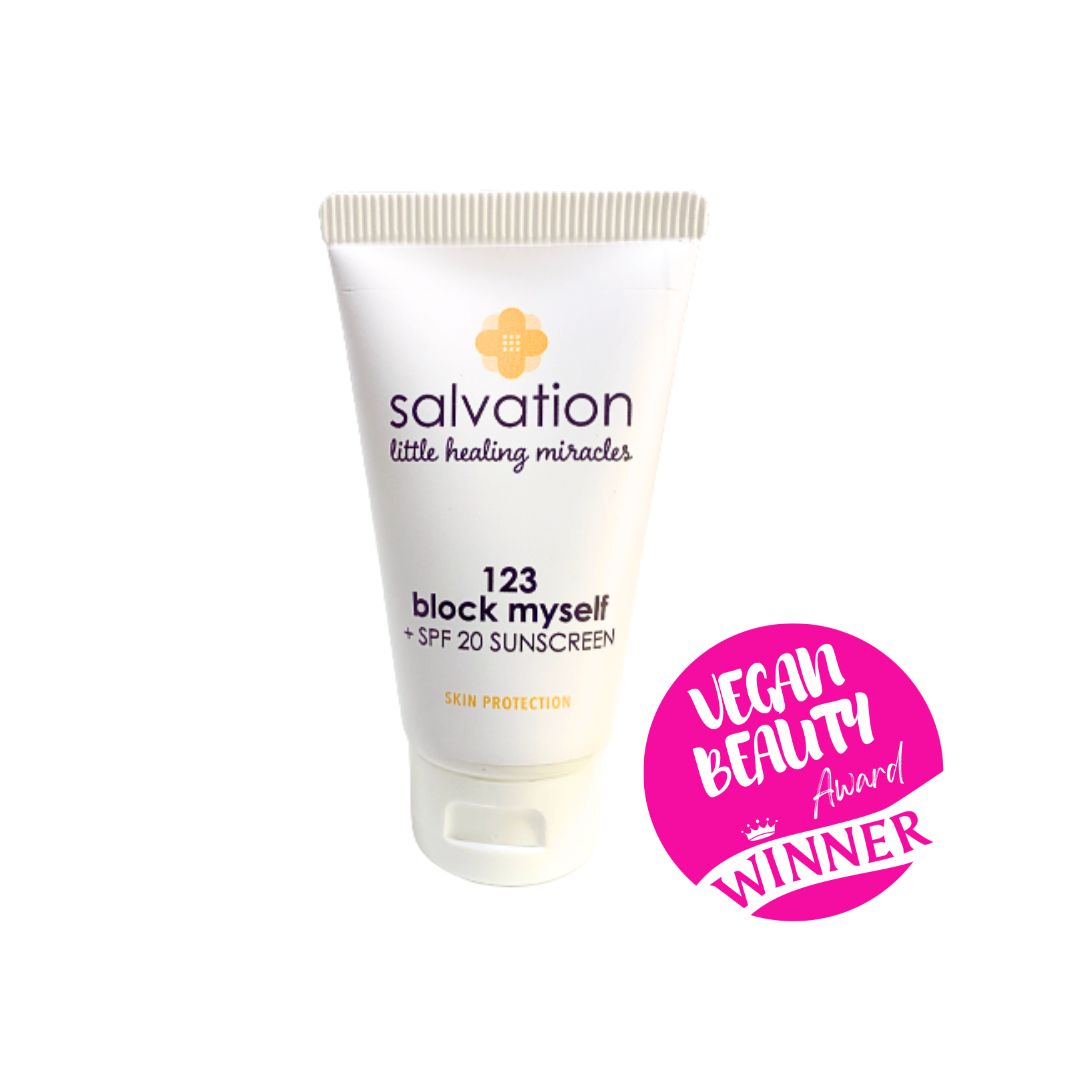
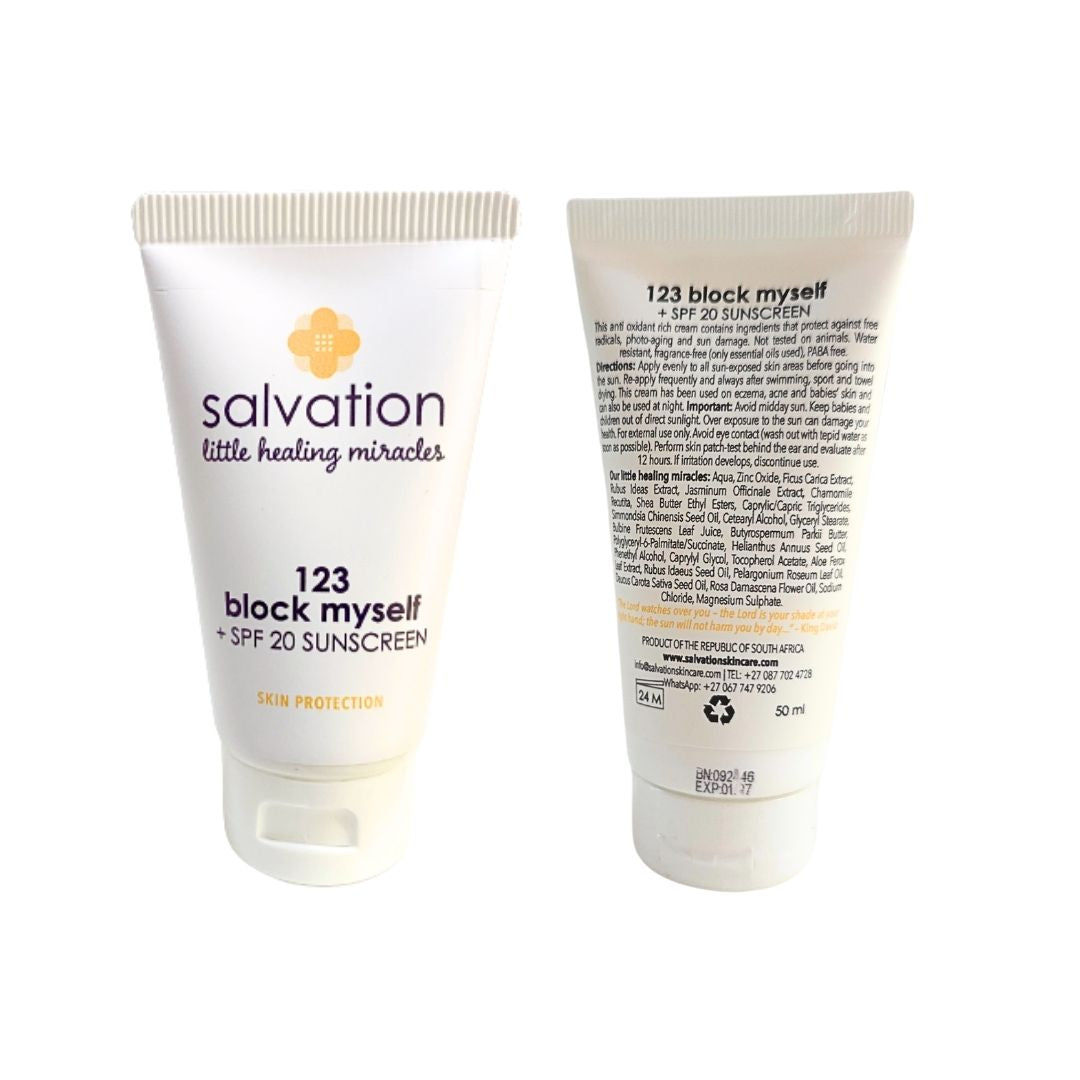
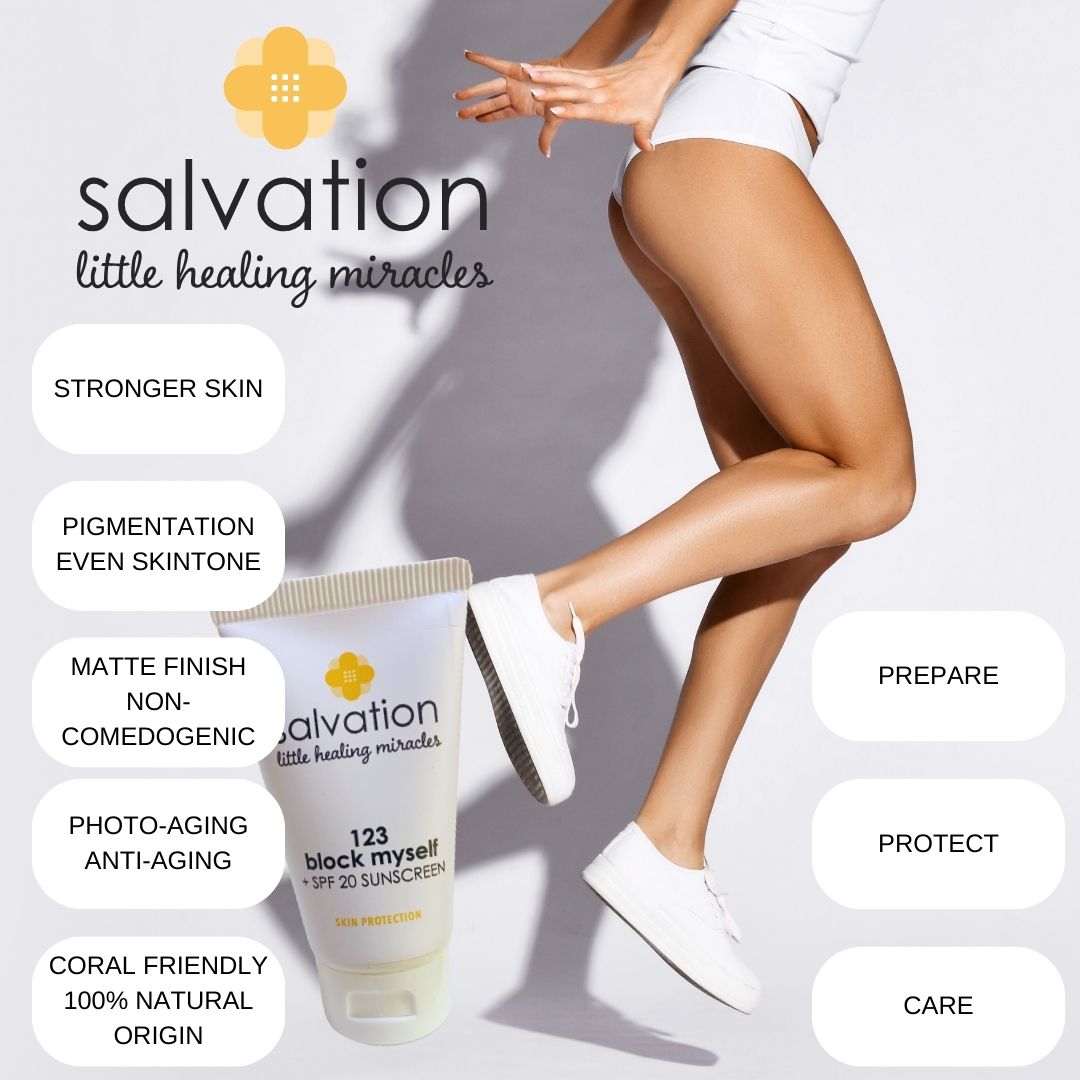
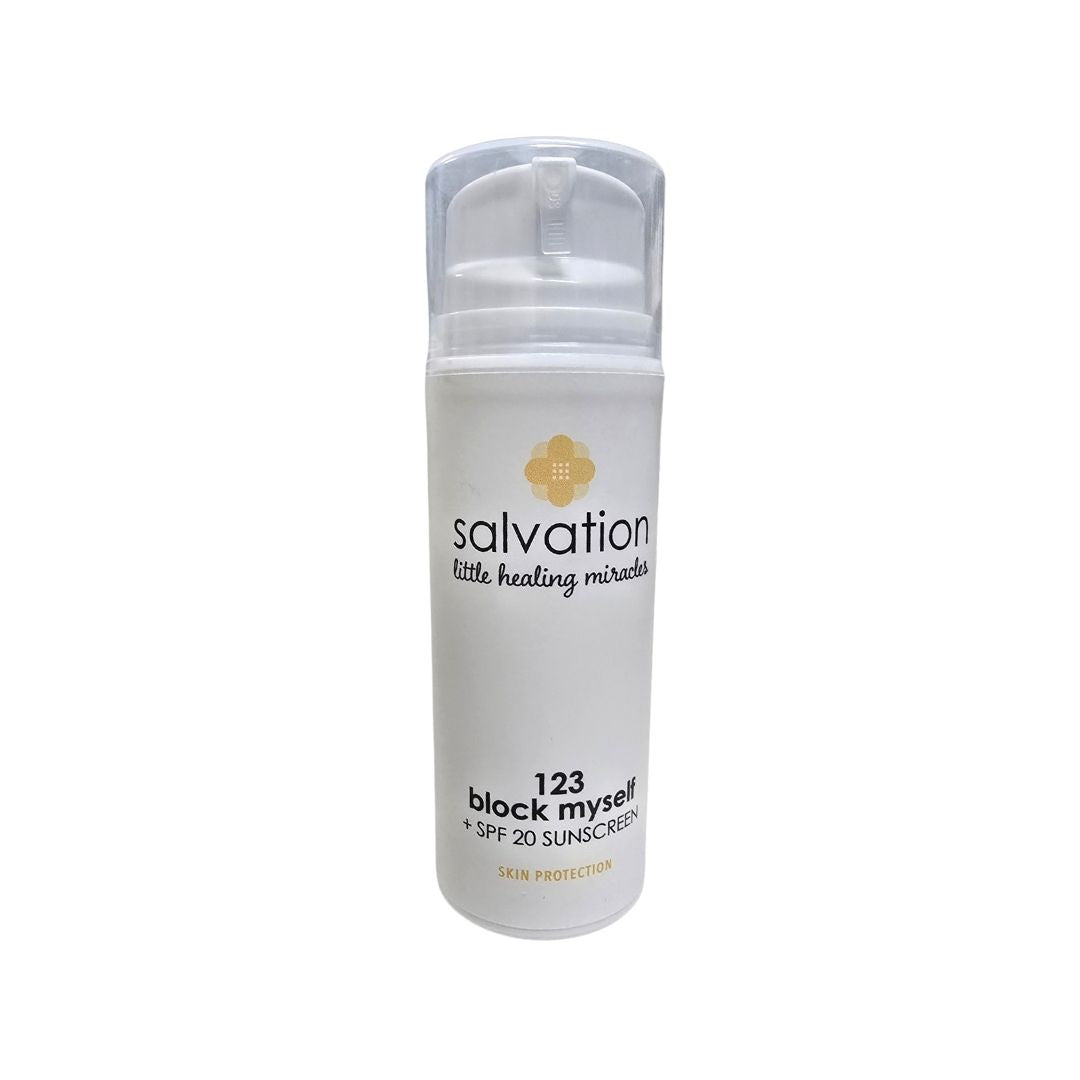
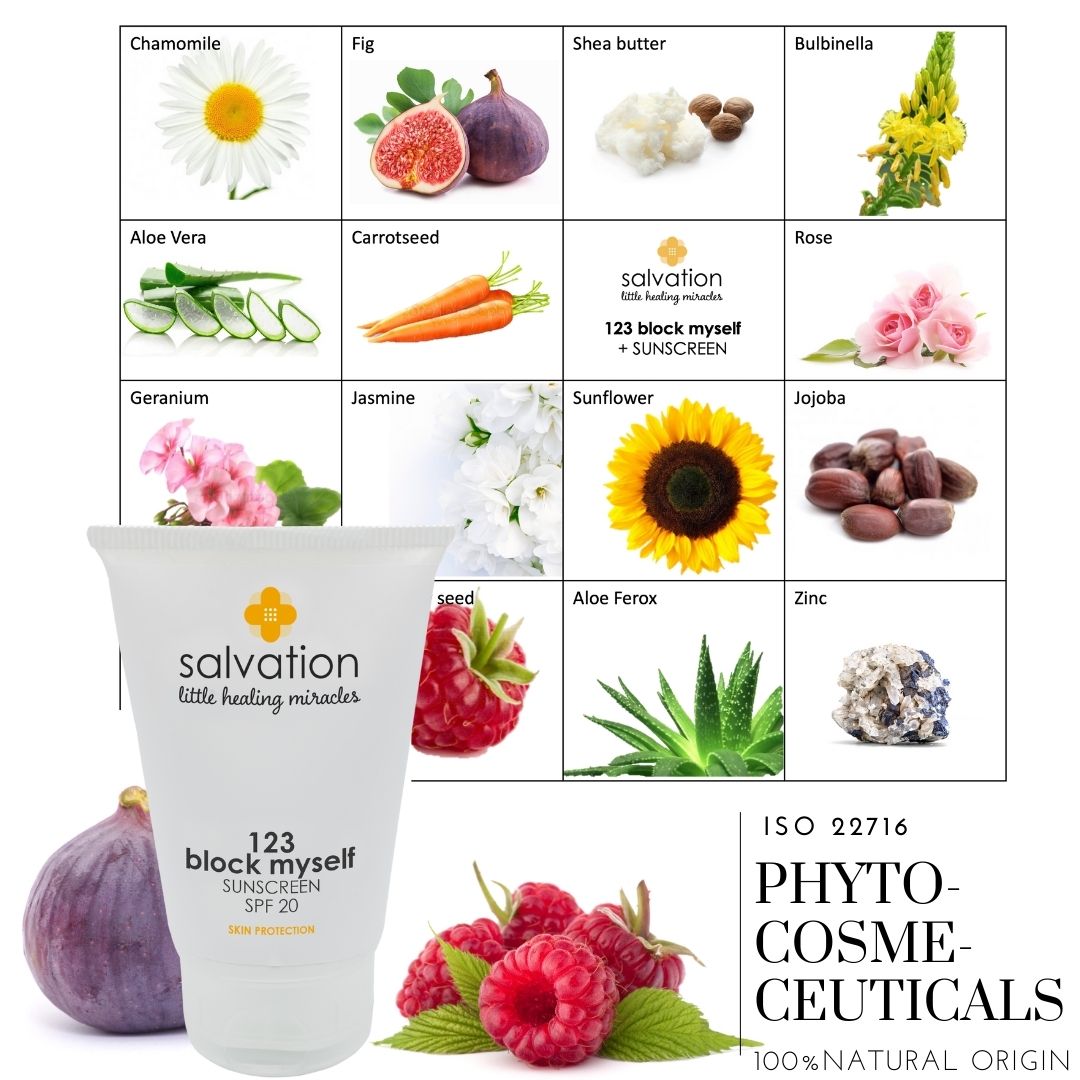
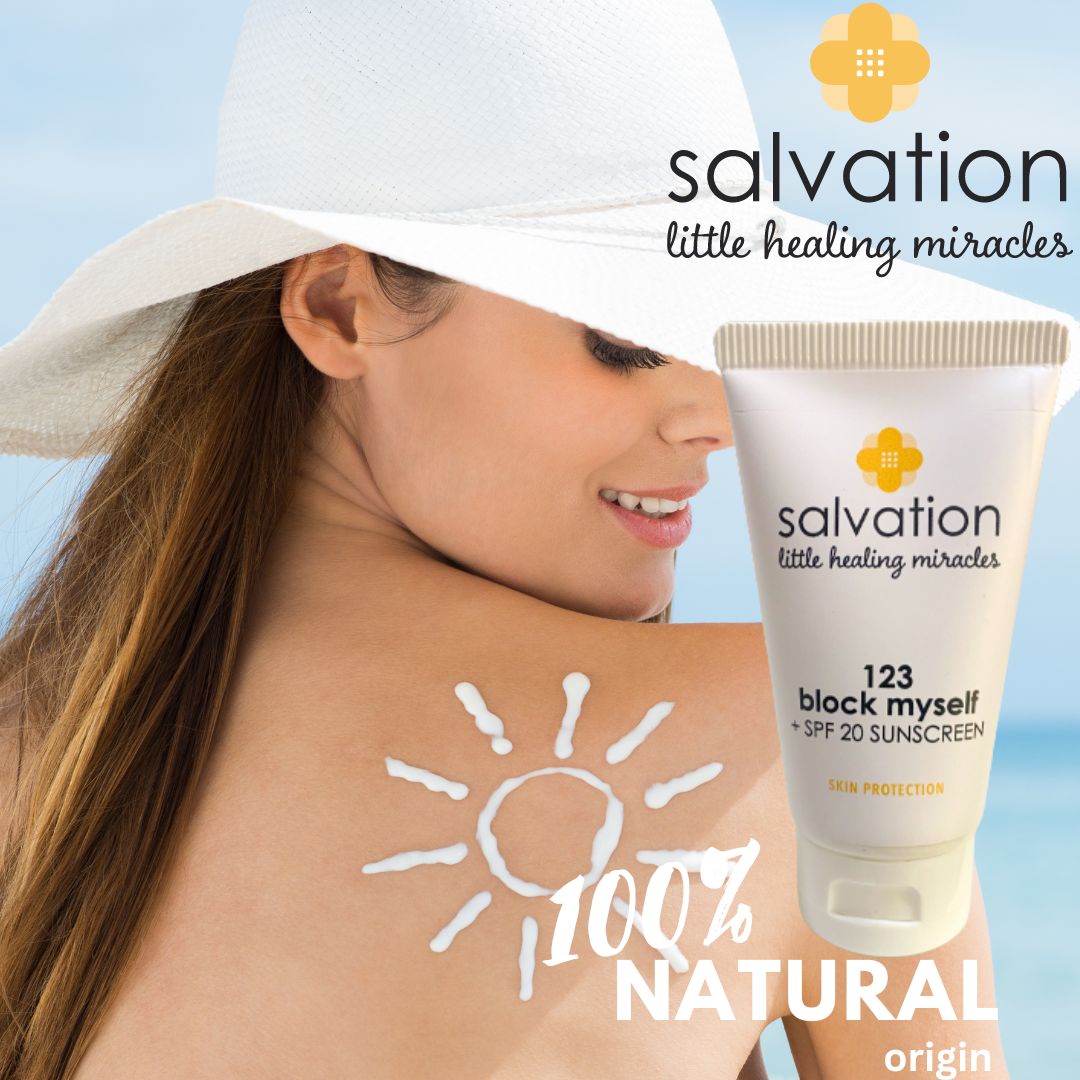
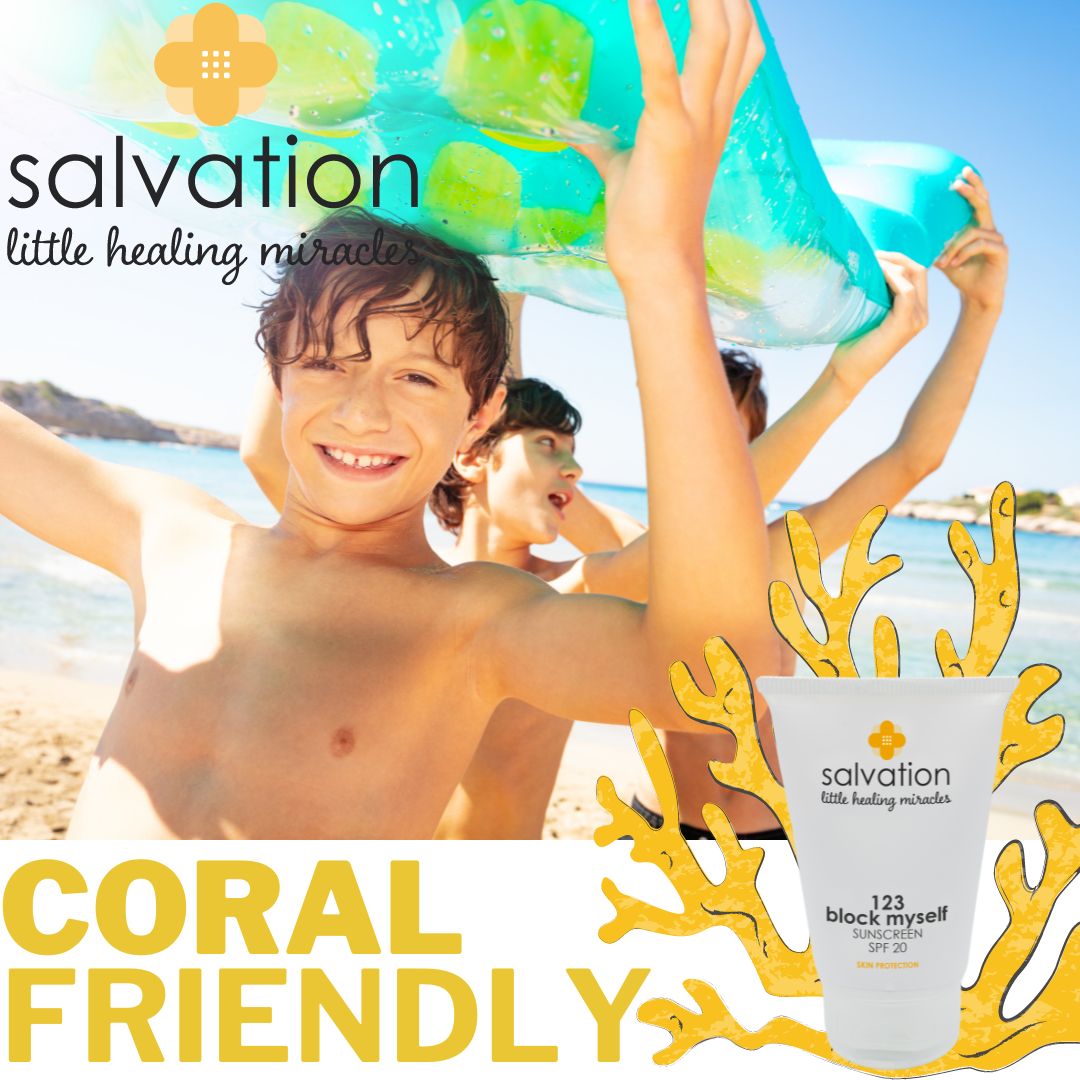

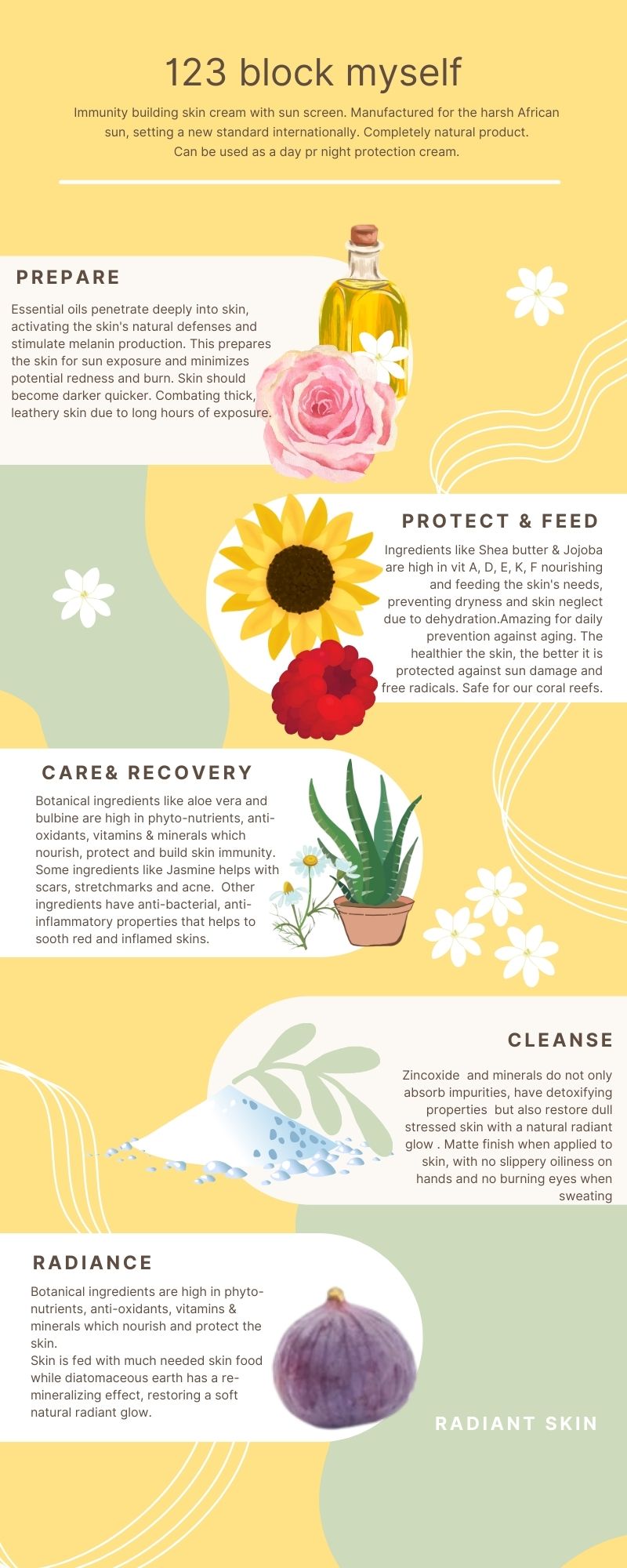
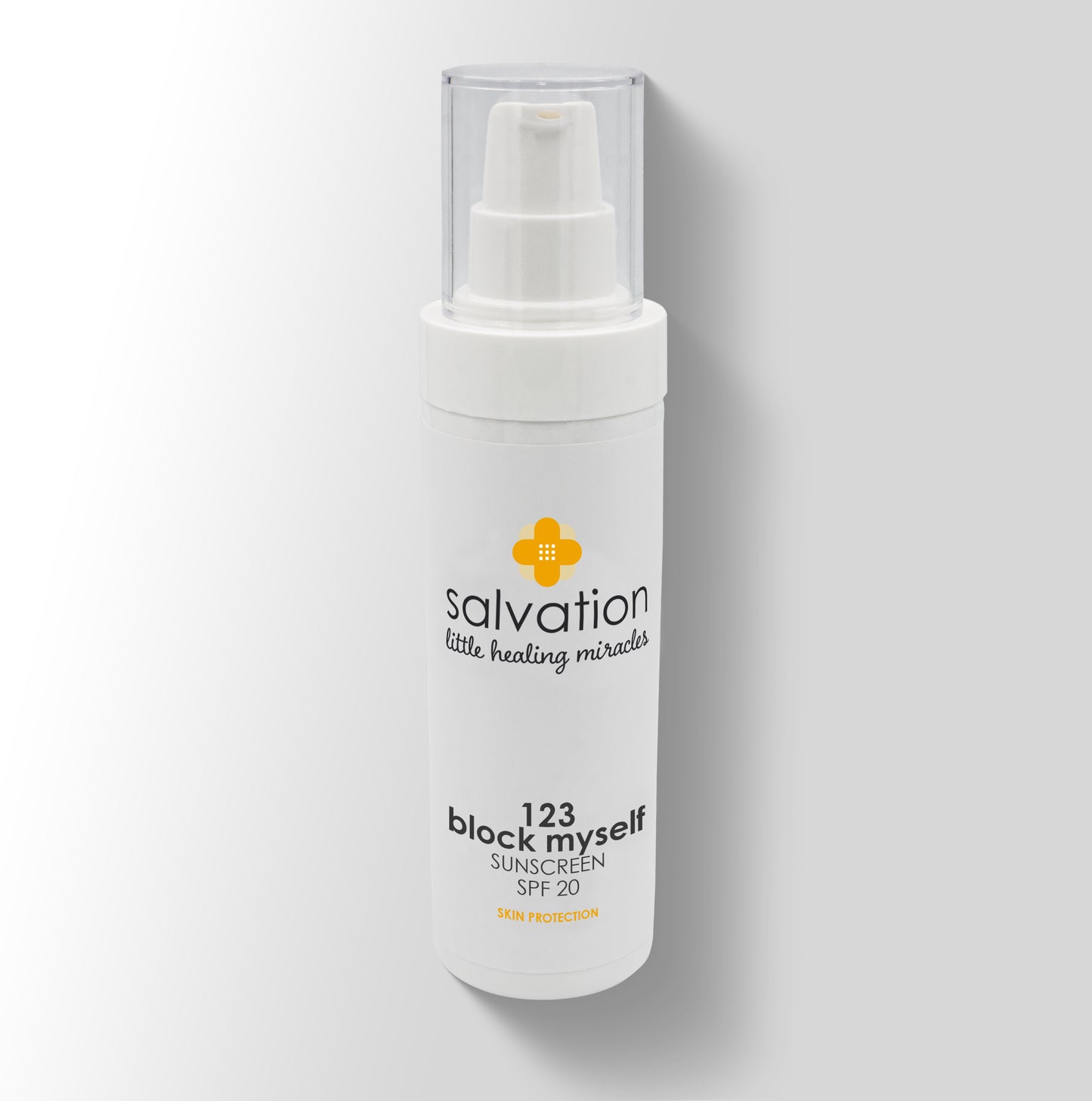
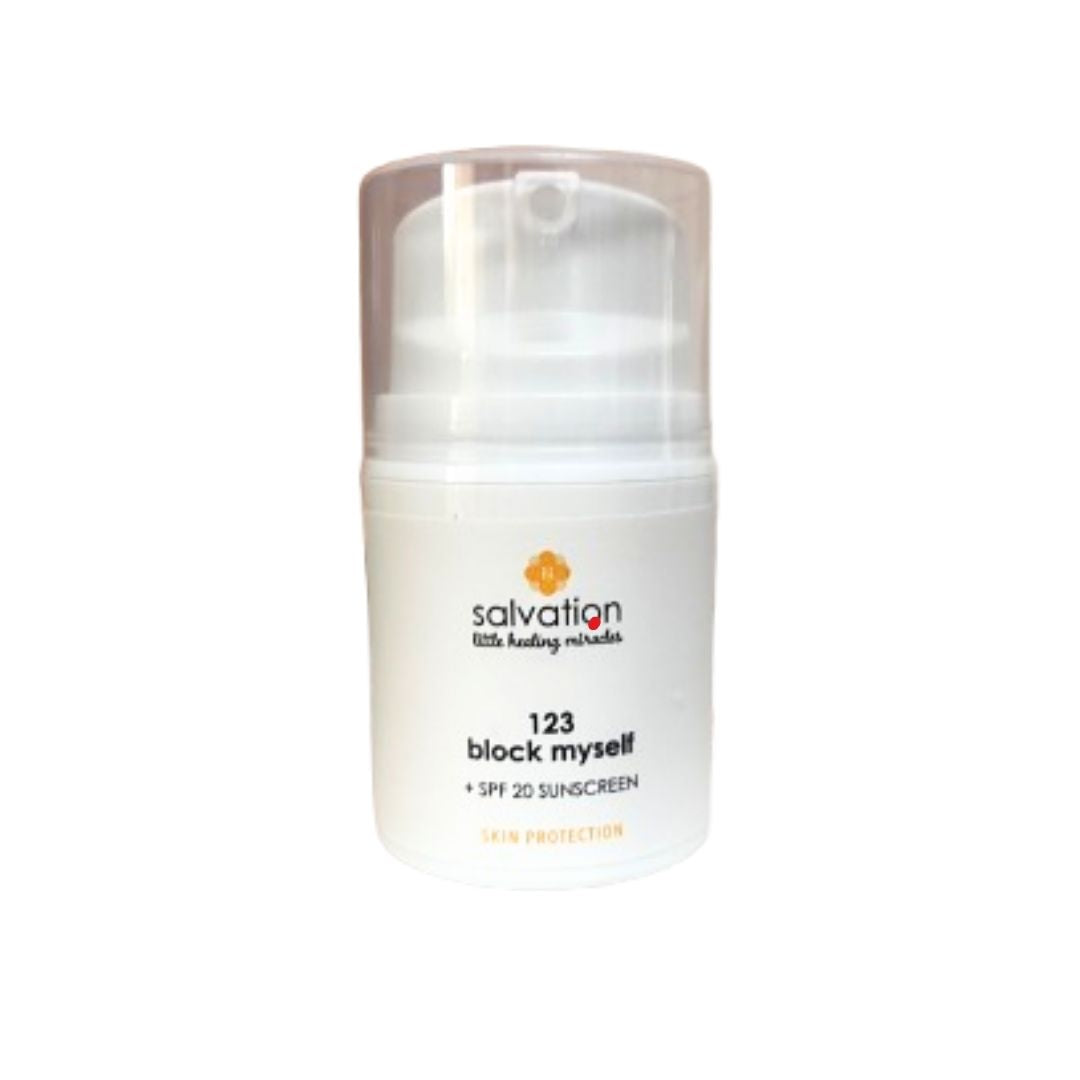
Why Salvation Skincare?



I never thought I’d find a sunscreen my husband, with his oily, breakout-prone skin, would love. But Salvation 123 Block Myself has been a game-changer! It's now the only thing he’ll put on his face. Knowing that the ingredients are safe and non-toxic gives me peace of mind, especially when applying it to our 3-year-old son and 1-year-old daughter. And because they love to copy Daddy's morning routine, it’s become a win-win for the whole family!
We were on holiday in Italy for 10 days walking 16 000 steps a day and watching Formula 1 racing in incredible heat. We applied 123 block myself and didn’t burn once. This was truly kncredible.
As a mum with little ones who have delicate skin, it’s no walk in the park to discover a sunscreen that I can have complete faith in and that won’t cause any irritation. That’s why I’m so appreciative of this specific brand. With a formulation that consists solely of natural ingredients, their ‘123 block yourself’ is exceptionally kind and moisturising to the skin. It offers reliable protection against harmful sun rays, all without the use of any scary chemicals!
What’s even better is that my kids don’t put up a fuss when it’s time to apply it, making my life a little bit easier! The reason being; that it absorbs into the skin like a dream and unlike a lot of other sunscreens, doesn’t leave any oily or sticky feeling, which is fantastic. Plus, the pump bottle makes it super convenient for travel and reapplication on the move.
Another fantastic feature of this sunscreen is its compatibility with makeup. It doesn’t leave a white cast on the skin or make it greasy, which is often a problem with other sunscreens. I no longer have to wait ages before applying makeup, in fact, it doubles wonderfully as a primer, providing a matte finish that helps my makeup stay in place throughout the day.
In a nutshell, I cannot emphasise enough how amazing this sunscreen is. It has gone above and beyond my expectations. From its gentle and safe formula to its exceptional ability to shield the skin, it has become an integral part of my family’s skincare routine. I am definitely eager to explore more offerings from this brand in the future!
- Louise Jane, CEO The Vegan Beauty Awards (UK)
Cancer runs very strongly in my family, and I have a lot of moles that I have to get checked every year. This year I was told that 6 of my moles needed further consultation, after which the dermatologists got back to me, saying that 4 needed to be removed. From the day of my first consultation, I applied 123blockmyself multiple times a day. Two weeks later I had an appointment for another consultation and to remove the moles they felt uncomfortable with, but upon arrival, they only found fault with one of them. I ended up only getting the one removed and the dermatologist will keep an eye on the rest of them for the next year, but wow what a blessing this product has been!!! For someone with very sensitive skin, who loves to be outside there is nothing more important than good sunscreen, and there is no debate that this is the one I will be using for the rest of my life.
I have used many types of natural sunblocks over the years and my family of 5 were my best judges in finding one that we can ALL love and were motivated to use again. This was it! My kids never again complained about sticky fingers, plaster white faces or funny smells. It's a winner 🎉
